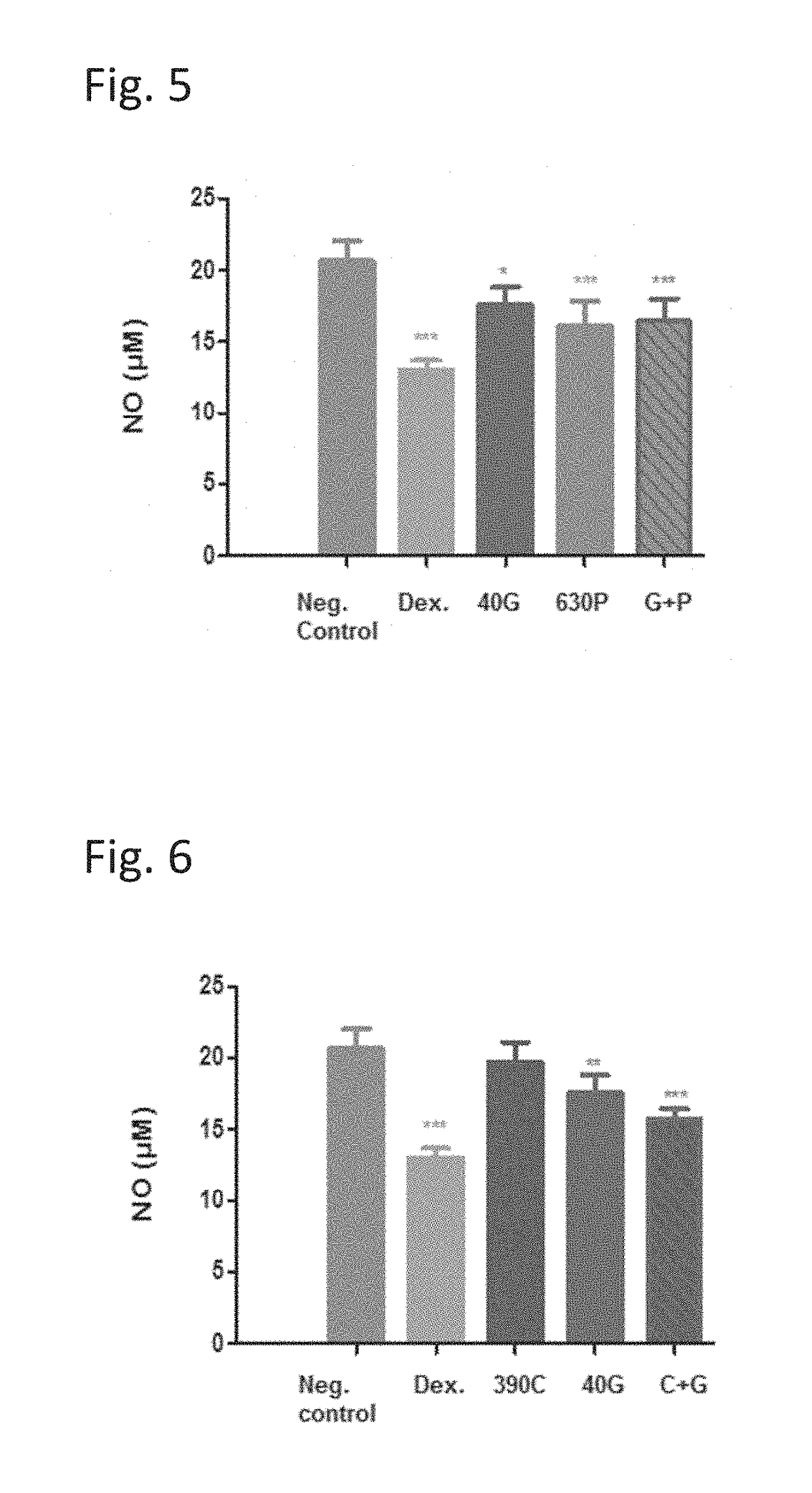Synergistic combinations of caffeine, ginkgo biloba and beta-phenylethylamine
a technology of ginkgo biloba and caffeine, which is applied in the directions of ginkgophyta medical ingredients, plant ingredients, pill delivery, etc., can solve the problems of increased risk of cardiovascular problems, increased side effects, and increased appetite, and achieves significant anti-inflammatory activity.
- Summary
- Abstract
- Description
- Claims
- Application Information
AI Technical Summary
Benefits of technology
Problems solved by technology
Method used
Image
Examples
example 1
Introduction
[0091]The three obligatory components of the claimed composition were tested in an in vitro model of inflammation (nitric oxide (NO) production), in order to determine whether said components possess anti-inflammatory activity when tested individually and / or in combination.
[0092]Methods:
[0093]105 cells from a murine macrophage cell line, RAW 264.7, were seeded in 96-well plates in a medium containing 1% FBS, 1% Glutamine and 1% Pen / strep in DMEM. The cells were then treated with either Caffeine (40 μg / ml), Ginkgo biloba (240 μg / ml), PEA (120 or 240 μM) or their combination (Ginkgo+PEA+Caffeine) at the indicated concentrations for 22 hours, together with LPS induction (5 ng / ml). In addition, positive control cells were treated with 20 μM dexamethasone. Nitric oxide (NO) release was tested after incubation at 37° C., 5% CO2 using the Griess Reagent System. The method is based on the chemical diazotization reaction that was originally described by Griess in 1879, which uses...
example 2
Immediate Release Tablets
[0125]Mix together 2 kg standardized herbal extract of ginkgo biloba with 6.6 kg PEA.HCl and 1.3 kg caffeine, all components being milled until a particle size distribution (PSD) of 100-250 micron was achieved.
[0126]Add 5 kg microcrystalline cellulose PH 102 and 100 g Syloid and mix for 10 minutes
[0127]Add 50 g magnesium stearate and mix for 10 minutes.
[0128]Preparing Tablets in Two Strengths
1. Compress the resulting mixture into tablets, each tablet comprising 150 mg ginkgo biloba, 500 mg PEA.HCl and 100 mg caffeine.
2. Compress the resulting mixture into tablets, each tablet comprising 75 mg ginkgo biloba, 250 mg PEA.HCl and 50 mg caffeine.
example 3
Tablets Containing Part of the Ginkgo biloba Component in Extended Release Form
Coat 1 Kg standardized herbal extract of ginkgo biloba with Ethocel™. 10 cp in a ratio of 9:1 ginkgo biloba / Ethocel™, The coating can be done in a fluidized bed via top or bottom spray granulation.
Mix together 1 kg standardized herbal extract of ginkgo biloba and 1 kg of the Ethocel™ coated ginkgo biloba from above with 6.6 kg PEA.HCl and 1.3 kg caffeine, all components being milled to a PSD of between 100 and 250 micron.
Add 5 kg microcrystalline cellulose PH 102 and 100 g Syloid and mix for 10 minutes
Add 50 g magnesium stearate and mix for 10 minutes.
[0129]Preparing Tablet in Two Strengths
1. Compress the resulting mixture into tablets, each tablet comprising 150 mg ginkgo biloba, 500 mg PEA.HCl and 100 mg caffeine.
2. Compress the resulting mixture into tablets, each tablet comprising 75 mg ginkgo biloba, 250 mg PEA.HCl and 50 mg caffeine.
PUM
| Property | Measurement | Unit |
|---|---|---|
| weight ratio | aaaaa | aaaaa |
| weight ratio | aaaaa | aaaaa |
| weight ratios | aaaaa | aaaaa |
Abstract
Description
Claims
Application Information
 Login to View More
Login to View More - R&D
- Intellectual Property
- Life Sciences
- Materials
- Tech Scout
- Unparalleled Data Quality
- Higher Quality Content
- 60% Fewer Hallucinations
Browse by: Latest US Patents, China's latest patents, Technical Efficacy Thesaurus, Application Domain, Technology Topic, Popular Technical Reports.
© 2025 PatSnap. All rights reserved.Legal|Privacy policy|Modern Slavery Act Transparency Statement|Sitemap|About US| Contact US: help@patsnap.com



